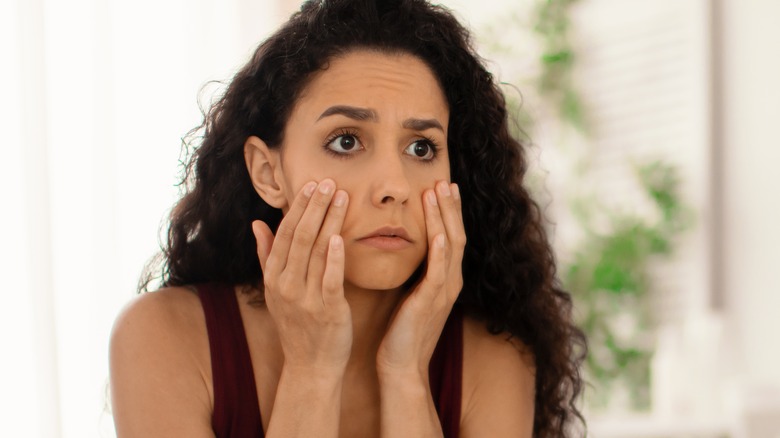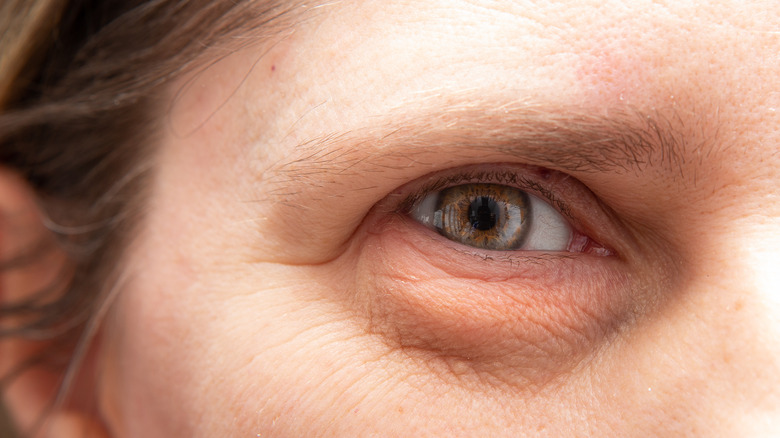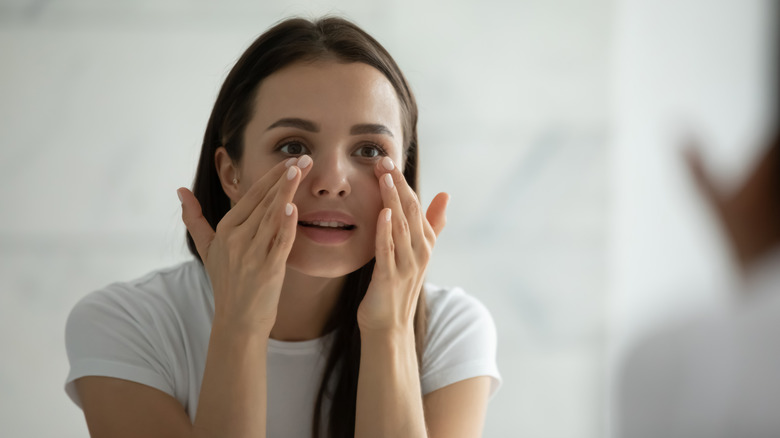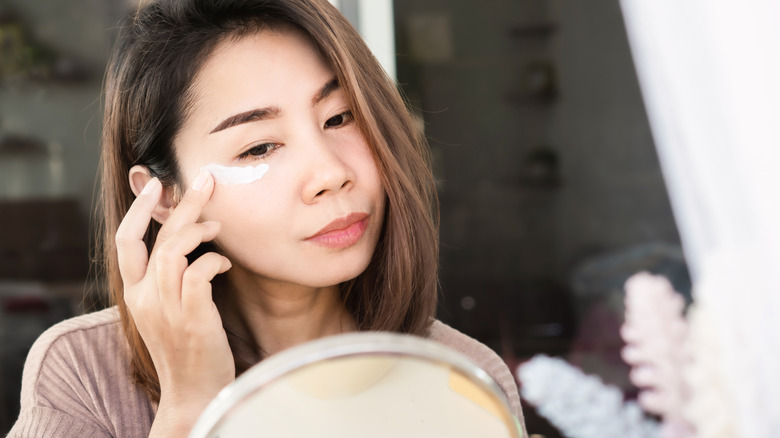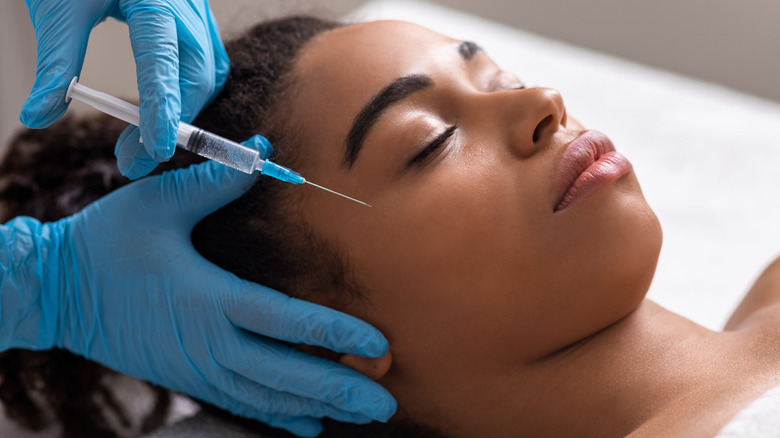The Difference Between Under-Eye Bags And Dark Circles Finally Explained
Thanks to the beauty industry, it isn't hard to think of things we dislike about our eyes. Two of the biggest concerns for most people are dark circles and under-eye bags. Apparent flaws in the skin under your eyes can disrupt your desired makeup look, or make you feel insecure about appearing tired or old. For this reason, your eyes are a lucrative business for skincare brands. Brightening, tightening, lifting, and smoothing are just a few of the benefits that eye creams and serums claim to provide. But despite the popularity of eye-centric skincare products, few people understand what's actually going on with the skin around our eyes.
As undesirable as under-eye bags and dark circles might be, they are natural features that everyone has in some shape or form. Unlike what some beauty products imply, eye bags and dark circles are also distinct traits with different causes. Learning about these differences could radically improve your eyecare routine.
Dark circles vs under-eye bags
The terms dark circles and under-eye bags get thrown around quite a bit, but what do they actually mean? For starters, both dark circles and under-eye bags are related to the physical structure of your skin, so no amount of sleep will magically transform your eyes into smooth, Photoshopped miracles.
Dark circles describe the dark pigmentation of the skin under your eyes. You may have a purple or blueish curve that covers a large section of skin, or you may just have a subtle darkness below the corners of your eyes. There are many causes of dark circles under your eyes, but most often it comes down to genetics. Thin skin around the eyes and hyperpigmentation are inherited traits (per Cleveland Clinic). But while dark circles are a part of your natural appearance, the feature can be exacerbated by a lack of rest, sun exposure, and aging, so it's still worth keeping up with healthy skincare and lifestyle choices.
Under-eye bags are an entirely different feature. They are the sagging skin below your eyes that is caused by aging. Per Mayo Clinic, your skin and muscles get weaker with age, causing the skin to droop and fat to move from your upper eyelids to your lower eyelids, which results in that puffy appearance. Eye bags are a normal cosmetic change that happens as you get older, so if they don't bother you, feel free to leave them be and carry on with your life.
What are puffy eyes?
Before we dive any deeper into the world of dark circles and under-eye bags, it's worth it to take a moment to explain puffy eyes. "Puffy" is an absurdly broad term that can refer to a lot of skin conditions, making it easy for any product to claim to treat puffiness.
If you complain about your eyes being puffy, observe your skin more closely. It's tempting to call what you see "eye bags," but unless you're older and noticing wrinkles and changes to the fat distribution in your face, you probably don't have under-eye bags.
Usually, a young person's puffy eyes are caused by inflammation. Your eyes can get swollen for all kinds of reasons, such as allergies or being underslept. This kind of swelling is temporary and you can reduce it in the mornings with cold compresses or gentle massage. Look for products that target inflammation instead of eye bags, such as eye creams that contain caffeine. Per Byrdie, dermatologist Corey Hartman recommends keeping your caffeine products at a cold temperature for an extra anti-inflammatory effect.
Long story short, if you are a young person with puffy eyes, don't waste your money on anti-aging products and focus on anti-inflammatory treatments instead.
How to reduce dark circles
Don't let anyone tell you that dark circles are unattractive. You can always embrace your dark circles and incorporate them into a moody, natural makeup style. That said, if dark under-eye circles don't suit your aesthetic, there are steps you can take to reduce their prominence.
Various skincare products say they'll reduce dark circles, but only certain active ingredients will make a significant difference. Since dark circles are often related to thin skin, you might benefit from retinoids that strengthen and thicken your skin, explains dermatologist Dendy Engelman to Self. Peptides are another potentially useful ingredient for strengthening skin since they can promote collagen production (per Healthline). You'll also find a lot of products for dark circles and deep eye troughs that contain hyaluronic acid. Hyaluronic acid is a beloved skincare ingredient, and while it is effective for moisturizing, a topical product won't have a major plumping effect (via Harvard Medical School).
If your primary concern is hyperpigmentation, look for brightening ingredients, such as vitamin C. Vitamin C reduces the melanin in your skin, the substance that causes darker pigmentation (per The Journal of Clinical and Aesthetic Dermatology).
Aside from skincare products, the easiest way to handle dark circles is with makeup. Apply a color-correcting concealer, usually in peach or orange to neutralize the blue tone of dark circles, and follow with a brightening concealer that matches your skin tone.
Can you get rid of under-eye bags?
Addressing under-eye bags is more difficult than dark circles. Unlike the inflamed skin you get when you're younger, under-eye bags are a result of a structural change in fat, skin, and muscle in your face. Because of this, the only way to get rid of them is with help from a plastic surgeon.
A lower blepharoplasty is the typical treatment for under-eye bags. This surgery involves moving the fat below your eyes and lifting the skin (via American Academy of Ophthalmology). If you would prefer a less invasive procedure, you can get under-eye fillers, also known as dermal fillers, or Botox injected into areas around the eye bags. According to the American Society of Plastic Surgeons, these fillers can modify the skin near the eye bags for smoothing and tightening purposes, but they won't reduce the fat.
Eye bags are a universal adult trait, and, contrary to what the faces on the red carpet might suggest, most people don't take steps to surgically remove them. Reducing inflammation, strengthening your skin, and using makeup are all great ways to beautify your eyes, but once you get true under-eye bags, it's best to accept the change as a part of life's natural journey.
